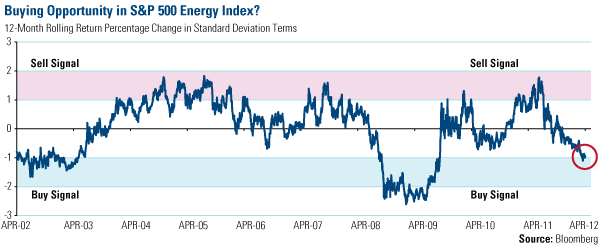Energy and Natural Resources Market Radar (April 30, 2012)
The S&P 500 Energy Index has decreased about 8 percent over the past 12 months. This decline represents a one-sigma event in standard deviation terms. Historically, this has occurred only 18.5 percent of the time in the past 10 years. As shown in the chart below, there were only two episodes when performance was worse on a one-year rolling basis: During the 2002-2003 period and during the global financial crisis in 2008-2009 when the U.S. was in a recession. To us, the S&P 500 Energy stocks represent a buying opportunity, as adding to core positions after a correction is a prudent way to invest.

Strengths
- According to the World Steel Association, global steel production rose 1.8 percent year-over-year to 132 million tonnes in March and China produced 46.6 percent of the world’s crude steel.
- Emerging market oil fundamentals continue to improve with Indian oil demand in March higher year-over-year by 5.4 percent (175 thousand b/d) to a record high of 3.403 mb/d. Diesel demand was higher year-over-year by a strong 10.8 percent (143 thousand b/d) to 1.464 mb/d, buoyed by higher diesel penetration in automobiles and strong growth in the power sector too.
- Central bank gold buying in March was confirmed by a data release from the International Monetary Fund on Tuesday. Mexico's central bank purchased 541,000 ounces during the month, Russia added 532,000 ounces, Turkey bought 369,000 ounces and Kazakhstan's reserves rose by 138,000 ounces. Although the buying is not large relative to central bank purchases over the same period in 2011 (for Mexico in particular), confirmation that central banks are still net buyers should be overall positive for the market.
- According to the China Electricity Council (CEC), electricity consumption in the country grew by 6.8 percent year-over-year in first quarter 2012 to 1,166 billion kWh. Meanwhile, March’s growth rate was 7 percent year-over-year, with a decent pickup from manufacturing industry consumption at 7.6 percent year-over-year compared with 2.1 percent year-over-year for the quarter as a whole. Copper hit a three-week high on Friday as tight supplies of the metal outside China kept prices supported, although there are worries about the escalating debt crisis in Europe following a Spanish credit downgrade.
- In a sign of tightening supplies, copper inventories in LME-registered warehouses fell to their lowest levels since November 2008 at 251,825 tonnes, with cancelled warrants - the metal earmarked for delivery - at 39.5 percent of total stock. In Shanghai, copper stockpiles fell to the lowest since February to 204,762 tonnes.

Weaknesses
- World Steel (WSA) published its updated Short Range Outlook for apparent steel use. The 2012 forecast was revised down by 3.5 percent to 1,422 million tonnes. Tonnage wise, this is mainly driven by China where the 2012 forecast was revised down by 33 million tonnes, or 4.8 percent. The global revision was 51 million tonnes. The forecast for the EU-27 was revised down by 5 percent and the NAFTA estimate is up slightly by 0.6 percent. 2012 growth is expected to be 3.6 percent, down from 5.6 percent in 2011. Steel use in 2013 is expected to grow 4.5 percent. Growth in China is expected to be 4 percent both in 2012 and 2013. These forecasts from WSA regarding Chinese steel use growth are the lowest ones yet. Chinese steel usage is expected to be 45.6 percent of global usage in 2012. The EU-27 is the only region where steel use is expected to fall in 2012, by 1.2 percent.
- According to the National Development and Reform Commission, China’s crude oil output fell 1.4 percent year-over-year to 50.03 million tonnes in the first three months of 2012.
Opportunities
- Credit Suisse estimates that Chinese total oil demand will rise to 12.2 million barrels per day by 2015, up from approximately 10 million barrels per day currently and will reach 15 million barrels per day by 2020 as China’s car fleet grows to record levels.
- Japan will continue using U.S. coking coal as an alternative to major suppliers such as Australia, but for the longer term, countries such as Mozambique and Russia will play a larger role in the Asia-Pacific coking coal market, the head of Japan's steel association said this week. Coking coal imports by Japan from its top supplier in Australia will fall sharply in April and May due to force majeure declared on April 2 by BHP Billiton Ltd. and Mitsubishi Corp. at mines they jointly own, Hayashida said. This was due to strikes and heavy rain. Japan's imports of U.S. coking coal surged in March, rising 57 percent on the year, while its imports from Australia dropped 17 percent, government data showed.
Threat
- Peru’s miners plan to start a national strike on May 14 to protest worker layoffs at mines and refineries, said Luis Castillo, General Secretary of Peru’s Mining Federation. Miners are protesting the dismissal of workers at Gerdau unit Empresa Siderurgica del Peru SAA and Shougang Corp.’s Hierro Peru iron mine, as well as a decision by creditors to liquidate Renco Group Inc.’s zinc smelter, Castillo said. Union officials will meet for talks with President Ollanta Humala, he said.













